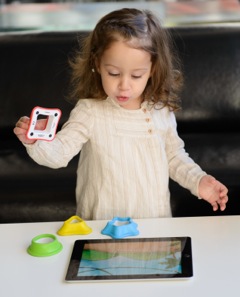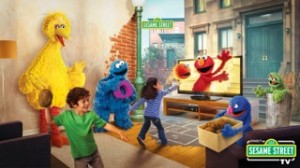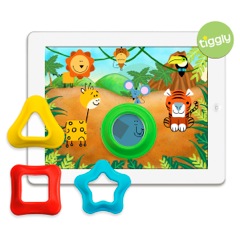
Image courtesy of Tiggly.
Azadeh Jamalian has spent the past four years studying how three- and four-year-olds learn math—using adults as her lab rats. Videotaping adults as part of her PhD work at Columbia University, she found that as they worked through problems, hand gestures were key. The harder the problems, the more they moved their hands. And the more they moved their hands, the more accurate their problem solving.
Using our hands, Jamalian realized, is crucial to learning—and something slightly missing in the 2-D world of flat screens where children primarily swipe and tap. So Jamalian is working to stitch more physical components into the digital world of early childhood apps—and as the co-founder and chief learning officer of interactive toy and app maker Tiggly, she’s in the right position.
“The whole premise of manipulating and playing with real objects is a big part of a child’s learning process,” says the New York–based Jamalian. “There is a lot of learning in this interaction that is missing from play on digital devices. At the same time, digital play can be beneficial for them by giving them feedback and scaffolding. So we’re trying to combine them together for the best experience possible.”
Touching is how babies learn their mother’s face and how they understand the difference between hot and cold, as well as how many young children learn to count. Studies even show that this touch interaction is mapped on our brain. Although children tend to grow out of counting on their fingers, a part of the brain corresponding to finger movement fires when they count in their head later in life, according to a 2012 study, “You Can Count on the Motor Cortex.”
The rise of digital devices, from tablets to laptops and phones to game consoles, has quickly spread into the early childhood arena, potentially limiting the opportunities children have to learn about objects and the world around them through touch. Research abounds on how these tools can enhance a child’s early learning skills. But game developers as well as educational app designers are now looking at their use from another angle—namely how to use apps and games to support crucial developmental steps that 2-D may not address.

Photo courtesy of Sesame Workshop.
Mindy Brooks, director of education and research at Sesame Workshop, for example, has been assessing how digital screens used with blocks can both educate a child while also supporting a more organic, physical style of play. The company already has games that children can play through Microsoft’s Kinect. But a new research project, Grover’s Block Party, that started in the fall of 2013 asks parents to videotape their children playing with blocks while a digital Grover talks about the object, knowing which one the child has picked. Children aren’t directed—they choose how they want to play. The digital element, here Grover, keeps up and interacts.
“It’s tricky about designing for motor movement with an app on a screen,” says Brooks. “We don’t allow a child to shake or tilt a tablet, because we don’t want them shattering. We’re also cognizant of the weight of tablets. But children come with the expectation of play with an app on screen and off, and it’s challenging to do that right now.”
Tiggly recently launched Tiggly Shapes & Apps, where children ages 18 months to four years play with a circle, square, star, and triangle in conjunction with an app. The goal is to have children play with the shapes, such as roll them along the ground, for example, things they cannot do as easily with shapes on a screen. Jamalian believes game and app developers should be looking more closely at weaving both online and offline into the early childhood space, as the digital can offer an educational component, with the physical also as core to the learning process.

Children 18 months to 4 years can play with Tiggly Shapes & App Image courtesy of Tiggly.
“We think physical play is important for spatial learning,” she says. “Manipulation of objects plays a big role in how we imagine different things. Just dragging or tapping is not as effective as hand rotating or touching different textures, experiences you cannot possibly have on a screen. At the same time digital play can be beneficial for them, giving them feedback and scaffolding. So we’re trying to combine them together for the best experience possible for their learning and their growth.”



This is a great article for more thought on using technology. However, in your article you make reference to 18 month old children using devices and how to adapt them for 3D learning. The Am. Pediatric Assn. recommends no use of devices for children under 3 years of age.
Also, research shows that verbs are learned by relating to body parts; i.e. “throw” is related to arm, “eat” is associated with mouth, etc. When older persons are put in a MRI and the word “eat” is presented the part of the brain associated with “mouth” lights up indicating the relationship.
Based on this research and working with language-delayed children it is my opinion that we should use the actual 3D objects in conjunction with the action for teaching young children. Now, that is not to say that these devices are not useful in education and teaching. There are many. But, we must be careful to have the human connection and the physical connection for teaching young children.